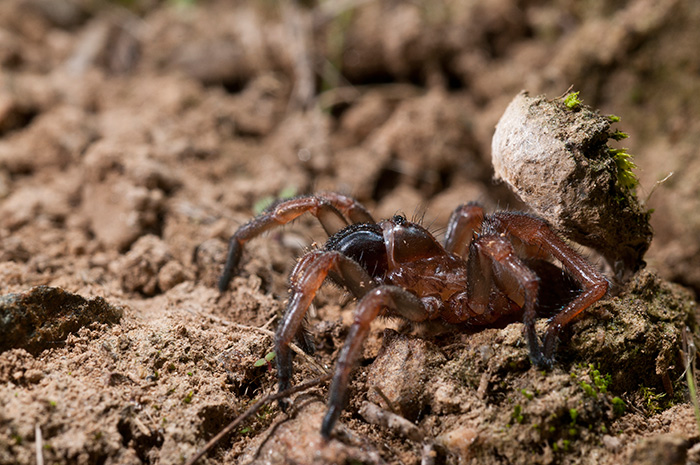
Mainly known like trapdoor spiders, these arachnids belong to the Orthognatha sub-order (Mygalomorphae); the big tropical species of this sub-order are incorrectly called “tarantulas”, but this appellation refer to the Italian wolf spiders, like Lycosa tarantula.
The Italian species are smaller then the famous tropical species.
The orthognatha have massive chelicerae, projecting forwards, articulated for upward and downward movement, unlike Labidognatha, that are articulated for inward and outward movement.
In Italy there are 4 families of them: Atypidae, Ctenizidae, Nemesiidae and Theraphosidae.
The first family has three species (Atypus affinis, A. similis, A. muralis), commonly named “purse web spiders”, because they create a special web, that is more like a sock, with a part buried in a deep hole and another smaller part, above the ground. The aerial portion is very difficult to see, in fact it is camouflaged with earth particles.
The aerial portion is used to hunter; the Atypus sp. wait under the silk, inside the “sock”, when the prey walk on the “tube”, the spider catch it with its chelicerae and carry it inside the burrow.
The second family has more species, grouped in three genres: Aepycephalus sp., Amblyocarenum sp., Cteniza sp.These are the true trapdoor spiders, they excavate a hole in the ground, until 30 cm of deep, like the precedent family, but in this case, there isn’t an aerial part.
They create a door, 4-5 mm thick, that close the burrow, furthermore it is very camouflaged.
In order to hunter other arthropods, the trapdoor spider wait under the door; when the prey is close enough, the spider go out, catch it but, to avoid being shut out, keep the posterior legs under the door.
Regarding Nemesiidae, there are many species of genus Nemesia sp. and one species of genus Brachytele sp. The construction of burrow and the process of capture of the prey is similar to previous spiders.
At last, the family of Theraphosidae contains only one species, Ischnocolus triangulifer, that lives only in Sicily.

